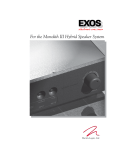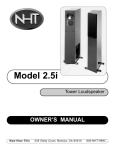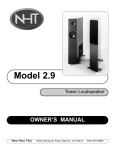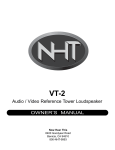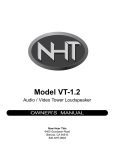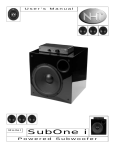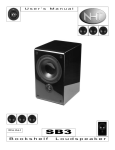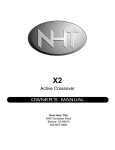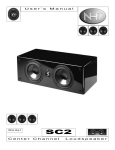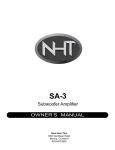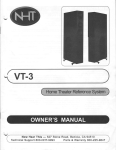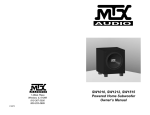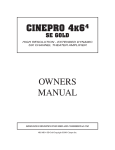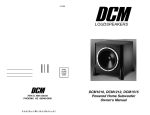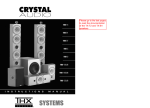Download NHT 3.3 Speaker User Manual
Transcript
Model 3.3 Reference Loudspeaker OWNER’S MANUAL Now Hear This 527 Stone Road, Benicia, CA 94510 800-NHT-9993 Thank you for your purchase of the NHT Model 3.3 Tower Loudspeaker. You have purchased a world-class loudspeaker that will provide you with many years of listening pleasure. We at NHT are proud of the Model 3.3 and we believe that you now own one of the best loudspeaker systems currently available. Please read through this Owner's Manual prior to installing your new speakers. The information provided will help you to obtain maximum performance from your audio system. If you have questions or require assistance at any time during the installation or operation of your new speakers, please call your NHT Dealer or our Toll-Free Customer Hotline at 1-800-NHT-9993. Please retain the Model 3.3's packaging to protect the speakers in the event that you move or transport them. Model 3.3 owners receive our highest level of customer service. Your Model 3.3 loudspeaker system has been precisely matched within O.3dB tolerance and we maintain recorded measurements of all 3.3 pairs produced. This ensures that we can provide precisely matched replacement parts if necessary. Please take a few moments to record the following information in this owner's manual. In the event that you misplace your sales receipt, this information will help us to provide prompt and accurate service. Ownership Record Name______________________________________________ Address_____________________________________________ City________________________________________________ State_________________Zip________ 3.3 Serial Numbers____________________________________ 3.3 Finish____________________________________________ Date Purchased__/__/_____ Dealer Name________________________________________ Dealer Address______________________________________ City________________________________________________ State________________ Zip________ ! The Model 3.3 Reference Loudspeaker NHT loudspeakers are designed to deliver refined, musical sound from attractive and affordable packages. Our efforts are guided by the study of human hearing and are optimized for real-world use. Every NHT speaker undergoes rigorous testing and quality control at the factory to ensure you years of listening pleasure. The Model 3.3 represents the ultimate expression of NHT's design philosophy, embodying ideas and innovations that transcend present limitations on the path towards that elusive goal: perfection in the reproduction of sound. 2 At NHT, we believe that a loudspeaker of this caliber should demand little compromise from the listener. That's why everything we know went into the 3.3...all our technology, our experience, our listening abilities. We admit we can't quite offer you perfection, but we can deliver sound beyond anything you have ever heard in your home. ! Design Goals • • • • • Extremely flat, smooth frequency response for a new standard in neutral, transparent sonics Ideal impulse response and radiation pattern for state-of-the-art imaging Extremely low distortion and high power handling for natural dynamics Optimal wave loading at all frequencies for position insensitivity Superb transducers for frequency extension to the limits of human hearing ! Technology The Model 3.3 incorporates NHT's proprietary Focused Image Geometry design. This unique technology determines the 21-degree angle that defines the Model 3.3's unique cabinet, as well as the sound radiation pattern of the system: • The irregular enclosure shape greatly increases the ratio of direct to reverberant sound, reducing side-wall reflections and concentrating sound energy in the listening area. This greatly minimizes the effects of room acoustics on spectral balance. • The exact angles at which the sound from the speakers reaches the ears of centrally located listeners is calculated to create what is known in acoustics as minimum inter-aural cross-correlation. This technique allows the Model 3.3 to properly recreate the natural acoustic ambiance and perspective contained in good recordings. • The radiating axes of the left and right speakers are crossed, providing time-intensity trading, so that the stereo image remains focused and stabilized for a wider range of listening positions. • The cabinet shape also reduces the formation of internal standing waves, resulting in smoother midrange response. The thick-walled and heavily braced cabinet not only provides a solid foundation for the sound producing elements, it is also specially designed to provide each driver with the optimal radiating environment for its frequency range, creating its own "acoustical room." With the speaker correctly set up against the front wall, the massive, overdamped floor-loaded woofer always sees a 90° corner, the ideal environment for the propagation of low frequencies. Simultaneously, the upper range drivers are located on a narrow front baffle that extends out into the room, much like a minimonitor on a stand. This configuration minimizes room boundary effects such as side wall reflections, resulting in superior imaging and a natural tonal balance. ! The Model 3.3 and Home Theater With the increasing popularity of home theater systems and the advent of 5-channel music recordings, many audio / video enthusiasts are building combined entertainment systems for both music and movies. When the Model 3.3 is used in a home theater system, be sure to augment it with timbre-matched speakers to ensure a seamless soundfield. The NHT AudioCenter-2 is the appropriate matching center channel speaker, while the Models 3.3, 2.9, 2.5i or 1.5 will function as matching surround speakers. Alternately, the NHT HDP-2 hybrid dipole surround speaker is a good choice for rooms where a full-range dipolar surround speaker is preferred. ! SpikeKit Installation A SpikeKit is included with the Model 3.3 to provide optimum stability and to firmly couple the speakers to the floor for improved bass performance. Each 3.3 loudspeaker is shipped with its own SpikeKit. Caution: the 3.3 is unstable without the SpikeKit (or at least the stabilizer bars) installed. 3 fig. 1 To begin assembly, unpack the SpikeKit and inspect all the parts. The SpikeKit includes: (2) aluminum stabilizer bars, (4) aluminum cones, (4) stainless steel alien studs, (1) alien head wrench, (8) Phillips head machine screws and (4) rubber feet. Important: We recommend installing only the stabilizer bars until final placement of the speakers is obtained. This makes the speakers much easier to move. Carefully turn the speaker upside down or on its back, and attach the stabilizer bars with the Phillips head machine screws, using a #3 Phillips screwdriver (fig. 1). When installing the bars onto the bottom of the speaker, use your fingers to start all the machine screws in their holes before tightening them down. This will prevent crossthreading. Once you have found the ideal location for your speakers, you are ready to install the metal cones. Have someone help you: While one person tilts and holds the speaker to one side, carefully install the cones flush against the stabilizer bars using the supplied allen studs. The speakers are awkward to move after the cones are installed. Caution: The cones are very sharp. To avoid injury, use extreme care when handling and installing. ! Placement The Model 3.3 is a floorstanding tower speaker that requires no stands or mounting hardware other than the included SpikeKit. The Model 3.3 is designed for indoor use only. As the Model 3.3 is not a magnetically shielded loudspeaker, do not place it closer than 18 inches from a television. Unshielded magnets placed in close proximity to a television screen can cause discoloration of the picture. If you notice picture discoloration, move the speakers away from the TV until the problem disappears. To realize the maximum performance of the Model 3.3, you should be willing to invest some time for fine-tuning adjustments. Follow steps #1 - 6, referring to the diagram in fig.2. Prior to beginning this process, we suggest you select two or three of your favorite recordings to use while you optimize the speaker placement. Each time you move the speakers to a new position, take note of the changes you are hearing. This will help in guiding you to find the ultimate placement for your 3.3's. Be sure to have a tape measure and a level handy. 1. Move the speakers within 3" of the front wall Unlike traditional speakers, the Model 3.3 is meant to be placed very close to the front wall. This placement allows optimum loading of the low frequency driver and is critical for proper bass performance. If bass response is too heavy in your room, move the speakers away from the front wall an inch at a time. 2. Determine rough placement by listening position For smoothest response, the distance from the side walls should be different than the distance from the front wall. The speakers should be arranged as symmetrically as possible: equidistant from side walls, perpendicular to the front wall and parallel to each other. The drivers should face the listening area without obstruction from furniture. Arrange the speakers so that the distance between the listener and the center of the speaker plane is 1.5 times the distance between the speakers. This configuration puts the listener in the center of the stereo image. Begin your listening by sitting centered between the speakers. While listening to the first selection, close your eyes and listen for image focus and depth of sound between the speakers. Balance this image focus and depth with apparent stage width, listening for sound beyond the boundaries of the left and right speakers. Play all three recordings before completing this step. 4 3. Determine fine placement by moving the speakers inward or outward from each other 3" Move the 3.3's no more than 1/2" either toward or away from each other. Again make sure that the speakers are parallel to each other. Play the same three recordings again, listening for image focus, stage width and depth. Evaluate whether there is an improvement. If the overall performance is better, mark the position with a piece of masking tape, and continue moving the speakers in the same direction. Evaluate them again. Continue this process until you have determined the best balance of imaging, depth and sound-stage width. D Speaker Plane Center of Speaker Plane fig. 2 1.5 x D 4. Install the metal cones Now that you have the speakers in the best sounding position, install the metal cones onto the stabilizer bars (refer to "SpikeKit Installation" above). Once all four cones are installed, re-check your measurements, making sure that the speakers are still exactly parallel to each other. If you have hardwood floors or floors with a scratchable surface, you may choose not to use the cones because they will pierce the surface. Rubber feet are provided and can be used in place of the cones. Peel off the adhesive backings from the rubber feet, and place them over the holes where the cones would screw in. The disadvantage of using rubber feet is that you will not be able to adjust speaker tilt (step #5). 5. Adjust speaker tilt To start, adjust the cones as needed to ensure that the 3.3 is level and does not rock in any direction (use your level to be sure). Experiment with vertical axis by raising or lowering your ear level in the listening position. At one particular vertical position, you may notice more ambience and depth in the soundstage. If the improvement occurs when your ears are at a lower position, raise the height at the front of the speakers by slowly unscrewing the two metal cones on the front stabilizer bar. Likewise, if the improved sound occurs when your ears are at a higher position, raise the height at the rear of the speakers by slowly unscrewing the two metal cones on the rear stabilizer bar. Be sure not to unscrew too much, or the cones may come off. 6. Final points to remember You may want to repeat the setup procedures at some point after you have had a chance to live with the 3.3's for a while. You will find that subtle improvements can be made that you may have overlooked during the initial setup. Experimentation is the key to finding the best arrangement in your listening environment. Be patient, have fun, and remember that small changes in speaker position can sometimes have a significant effect on the sound. In addition, room furnishings play an important role in absorbing and reflecting soundwaves. Midrange and high frequencies in particular will be absorbed by soft furnishings such as sofas, carpets and curtains. A large number of these soft furnishings will dull the sound, while a "live" room with few furnishings will brighten the sound. ! Connections Before connecting speakers to your system, it is very important that you turn off the power to your amplifier / receiver to avoid damage to the equipment. 5 Model 3.3 loudspeaker system is compatible with virtually all quality amplifiers. Proper wiring of the speakers is essential to good sound. At a minimum, 14AWG speaker cable is recommended for runs of 10 feet or less, with heavier special purpose cable used for longer runs. For specialty cable considerations, consult your local authorized NHT retailer. For best results, use equal length runs of cable for the left and right speakers. Prepare your cable by stripping 1/4" to 3/8" of insulation from the ends and twisting the exposed wire strands tightly. The five-way binding posts on the back of the speaker will accept raw wire, banana plugs, or spade plugs. Tighten the binding posts by hand, as pliers can strip or break them. Be sure to wire both the left and right speakers "in-phase." That is, the Positive (red) terminal on the amplifier output must be connected to the corresponding Positive (red) terminal on the speaker. Likewise with the Negative (black) terminals. All speaker cables have some sort of marking along one or both conductors to help you make the correct connections. Incorrect speaker phase is indicated by weak bass and the lack of a well-defined stereo image. To minimize noise pickup, segregate cables by function. Do not run low level signal cables parallel to power cables, speaker cables, or digital cables. Also, do not run speaker cables or digital cables parallel to power cords or parallel to each other. If different types of cables are placed near each other at some place in your system, separate them by the maximum practical distance and cross them at right angles where they meet. Do not twist or tie AC power cords and speaker cables. ! Connection Methods On the back panel of the 3.3 there are two pairs of binding posts (fig. 3) with a metal jumper strap connecting the top and bottom pairs. There are three different ways to connect the 3.3's to your system: full range with a single amplifier, biamplified with two amplifiers and two sets of speaker cable, or biwired with one amplifier and two sets of speaker cable. Full Range To run the 3.3's full range with one amplifier / receiver, simply connect the speaker cables to either the top set or bottom set of binding posts (it doesn't matter which one). Biamplification Biamplification is the use of two separate amplifiers, one to power the bass drivers and one to power the midrange / high frequency drivers. Biamplification provides increased dynamic range and power output, as it allows both amplifiers to concentrate all their headroom toward a specific frequency range, sparing them the task reproducing full range information. To biamplify the 3.3, you will need two amplifiers: a main amplifier for the upper range drivers (top pair of binding posts) and a second amplifier for the subwoofers (bottom pair). The main amplifier can be a stand-alone stereo amplifier, dual monoblock amplifiers, or the amplifier section of an integrated amplifier or audio/video receiver that features "pre-out" and "main-in" jacks. The second amplifier may be a full range amplifier connected parallel to the main amplifier, or for more flexibility, the NHT SA-3 subwoofer amplifier. fig. 3 Biamplifying with the SA-3 is highly recommended, as this configuration turns the passive subwoofer section of the 3.3 into a fully adjustable powered subwoofer with onboard bass tuning functions. The SA-3 is optimized for low frequency amplification and allows the user to fine-tune the 3.3's bass response for a specific listening environment. For example, it is possible to increase or decrease the volume level of the subwoofer sections independently of the upper driver sections, to compensate for rooms that tend to under-emphasize or over-emphasize low frequencies. Additionally, the SA-3's low-pass crossover allows the user to adjust the rolloff of low frequencies to the subwoofer sections for further fine-tuning of the low bass and mid-bass regions. Note: It is very important that you remove the jumper straps when biamplifying or you will damage your amplifiers! Connect the top pair of binding posts with speaker cable from the main amplifier, and the bottom pair of binding posts with speaker cable from the second amplifier. If you are biamplifying with two full range stereo amplifiers that are not identical, make sure that one has an adjustable volume control so that you can match levels between the two. Both amplifiers will need to be wired in parallel from the preamplifier, so that they both receive an identical line-level input signal. If you are biamplifying with the SA-3 subwoofer amplifier, it may be connected in series or in parallel. For more detailed information, consult the SA-3 Owner's Manual or your local authorized NHT retailer. Biwiring Some audio enthusiasts have found that biwiring can bring about improvements in sound. Biwiring is the use of two pairs of speaker cable and one amplifier, with each pair connected to one set of binding posts on the amplifier (some two-channel amplifiers provide two sets). To biwire the 2.9's, connect the top pair of binding posts to the amplifier with one speaker cable, and the bottom pair with a second cable. The two sets of speaker cable are both connected to the same pair of terminals on the amplifier. ! Break-In Period The Model 3.3 loudspeakers will perform better after they have had a chance to break in. Several factors determine how long this process takes and it depends on such variables as room temperature, type of music played, and volume level. You may be aware of subtle changes in sound quality during the first few days of listening as the mechanical parts of the drivers begin to loosen up. ! Operation The Model 3.3 was designed to handle a wide range of listening levels, but every speaker has limits. It is important to use common sense and listen for signs of possible distress from the speakers. Underpowered amplifiers are most often the cause of speaker damage. For example, a 60-watt amplifier runs out of power when called upon to produce more than 60 watts, and the resulting distortion can damage the speaker. If you tend to listen at high volume levels, more powerful amplifiers are preferable because they are less likely to run out of power. Noticeable distortion or harsh breakup is an indication that either your amplifier or your speakers are running beyond their capacity, and the volume should be decreased. If you can feel any heat emanating from the woofer or tweeter, reduce the level immediately. Speaker damage most often occurs from sustained high volume levels, not from transient sounds or brief musical peaks. Excessive boosting of bass, treble or equalizer controls can worsen the problem, and is not recommended. ! Maintenance Your speakers require minimal maintenance under normal use. The cabinet may be cleaned using a damp cloth or a mild, non-abrasive cleaner. To clean the grille, first remove it from the speaker, then brush lightly with a soft brush or use a vacuum on its lowest setting. Do not expose the speakers to direct sunlight, high temperatures, or moisture. Do not attempt to clean the actual drivers. ! Model 3.3 Technical Specifications • System Type: 4-way acoustic suspension design, Focused Image Geometry • In-Room Response at 1M: 23Hz - 26KHz, +/- 2dB, typical • In-Room Response at 2M: 23Hz - 26KHz, +/- 4.5dB typical • In-Room Low Frequency Cutoff: 22Hz at 3dB • In-Room Low Frequency Useful Limit: 19Hz at 6db • Distortion at 87dB SPL: <0.4%, 35Hz to 20KHz; <2.5%, 20Hz to 35Hz • Distortion at 97dB SPL: <1.1%, 45Hz to 20KHz; <6%, 20Hz to 45Hz • Sensitivity: 87dB (2.83V at 1M) • Impedance: 6 ohms nominal, 4.3 ohms minimum, 10.5 ohms maximum, no phase angle over +30° • Recommended Amplifier Power: 30 Watts to 300 Watts per channel, 1000W peak input • Inputs: 1 pair of gold-plated 5-way binding posts for woofer input 1 pair of gold-plated 5-way binding posts for mid / high input • Weight: 123 Ibs. each • Dimensions: 42"H x 7"W x 31 "D, not including grille or stabilizer kit • Finish: Italian black satin laminate, high-gloss mahogany or sycamore laminate • Driver Information: Subwoofer: 12" polymer cone in 70-liter acoustic suspension enclosure Ultra-long throw 2-layer voice coil 59 oz. magnet in die-cast frame 19Hz free-air resonance Fc = 35Hz, Q[C = 0.65 12dB/octave low-pass at 100Hz Lower Midrange: 6.5" polymer cone in 10-liter anti-modal enclosure Long-throw 2-layer voice coil 42hfz free-air resonance Fc = 67Hz, OK; = 0.66 12dB/octave high-pass at 100Hz; 12dB/octave low-pass at 320Hz Upper Midrange: 4 polymer cone in 3-liter anti-modal enclosure Fiber-composite molded frame 110Hz free-air resonance 12dB/octave high-pass at 320Hz; 18dB/octave low-pass at 3.5KHz Impedance compensation Tweeter: 1" fluid-cooled aluminum dome 1.4KHz resonance 18dB/octave high-pass at 3.5KHz Impedance compensation • Crossover Information: Top quality, low distortion components, minimal topology 14 AWG soldered internal wiring 2-terminal biamplifiable, with passive network remaining in-circuit Specifications are subject to change without notice, in accordance with our policy of continuously upgrading the performance of our products. ! Performance Data Audio Precision NHT, INC. :30 JUN 93 16:03:39 +110 +105 +100 +95 +90 d B r +85 +80 +75 +70 +65 +60 20 50 100 200 500 1k 2k 5k 10k 20k Frequency Response 1M in room, 2.83 volts Hz Audio Precision NHT, INC. :02 MAR 93 22:42:51 100 50 20 10 5 2 % 1 0.5 0.2 0.1 0.05 0.02 0.01 20 50 100 200 500 1k Hz 2k 5k 10k 20k THD + N 2.83 volts Limited Warranty Valid Only in the U.S.A. Warranty Period For the period of 5 years for parts and 5 years for labor from date of original purchase (the warranty period) from an authorized NHT dealer, Now Hear This (NHT) warrants that if our product fails to function properly under normal use due to a manufacturing defect when installed and operated according to the owner’s manual instructions enclosed with the unit, it will be repaired or replaced with a unit of comparable value at the option of NHT without charge to you for parts or actual repair work. Parts supplied under this warranty may be new or rebuilt at the option of NHT. What’s Not Covered This warranty does not cover any product which is used in any trade or business, or in an industrial or commercial application. This warranty does not cover the cabinet or any appearance item, or any damage caused to the product resulting from: alterations, modifications not authorized in writing by NHT, accident, misuse or abuse, damage due to lightning or power surges, or being subjected to power in excess of the speaker’s published power rating. This warranty does not cover the cost of parts which would otherwise be provided without charge under this warranty, obtained from any source other than an authorized NHT service location. This warranty does not cover defects or damage caused by the use of unauthorized parts or labor or from improper maintenance. Altered, defaced or removed serial numbers void this warranty. Your Rights The liability of NHT will be limited to the purchase price of the product, and NHT will not be liable for incidental or consequential damages. NHT limits its obligations under any implied warranties under state laws to a period not exceeding the warranty period. Some states do not allow limitations on how long an implied warranty lasts, and some states do not allow the exclusion or limitation of incidental or consequential damages. The above limitations or exclusions may not apply to you. This warranty gives you specific legal rights, and you may have other rights which vary from state to state. To Obtain Service NHT has appointed a number of authorized service companies throughout the USA should your product ever require service. To receive warranty service, you will need to present your sales receipt showing place and date of original owner’s transaction. To find the name and address of the nearest authorized NHT service location, call or write: AB Tech Services, 17C Airport Drive, Hopedale, MA 01747. 1-800-225-9847. [email protected] Keep this warranty with your sales receipt. Record date and place of purchase for future reference.










